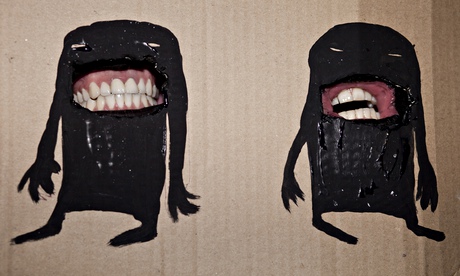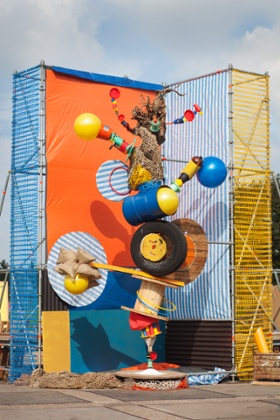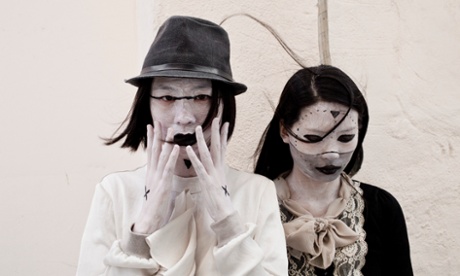Unseen photo fair: the Amsterdam weirdfest jampacked with genius
From barbecued photobooks to inflatable bouncy-castle clouds and the madcap brilliance of Augustin Rebetez, many shades of weird are converging in Amsterdam for the 2014 show

In the entrance hall, an escalator takes punters one by one up to a giant inflated cloud, which explodes with light when you leap on it. A picture of every jumping person is instantly loaded on to an ever-growing photographic cloud for the project, Trust the Cloud.
In the main square, a large sculpture is taking shape over the weekend: giant brightly coloured lightbulbs and spools hanging from gnarled branches covered in a fishing net. It is called A Durian Growing a Swinging Sponge on a Fractal Evening and is unmistakably the work of set painter-cum-artist Lorenzo Vitturi. There he is, perched on a crane, drill in hand, adding another bulb. An outgrowth of his Dalston Anatomy project (which saw him take strange, saturated shots of vegetables to show life on east London’s Ridley Road Market), the sculpture is the symbol of this year’s Unseen, which undercuts the commerciality of most art-photography fairs with moments of high mischief.

As night fell on Thursday, smoke filled the air outside the former gasworks. It was wafting from a barbecue bucket tended by London-based artist Melinda Gibson, who was inviting passersby to partake in a performance called The Smoke House. In four small smoke houses, copies of her new book (the latest Self Publish, Be Happy book-club offering) were absorbing wood and coal smoke. Once hot, they were sealed and sold to the public. It was, so the programme says, “a ritual act of defiance” linked to an actual fire that damaged Gibson’s studio recently – but it became a large gathering of revellers drawn to the campfire atmosphere. I went to dinner reeking of smoked photobook.
Earlier on, I had been introduced to Augustin Rebetez with the words, “You should check out this guy’s work. It’s pretty wild.” I did. It is. Rebetez makes photographs, drawings and films obsessively. At the Galerie Nicola von Sanger, his work covers two walls: primitive paintings, collages and photos of strange things that show a singularly dark imagination. Children look like zombies. A bald woman with kohl-rimmed eyes could be their undead mother. The legs of what look like a row of homemade electric chairs sprout shoes.

On a third wall, a bizarre single-frame animated film plays on loop: a dead crow flies from a wooden case and flutters around a house, in which bodies emerge from drawers, slither across bare floorboards and up a flight of stairs then disappear. Makeshift machine-men whirr frantically as though they are trying to take flight. It is as if Rebetez’s photographs and drawings have come to life in homage to the Quay Brothers. (Watch some of his videos here.)
Over at the book market, RVB books are selling Rebetez’s new bookAnthill Memories, which captures his relentlessly active imagination. Like the films, many of the the photographs were constructed around his house in the Swiss Jura mountains with the help of his friends – many of whom seem to be circus performers. Strangeness abounds: there’s a collapsing caravan, a crumpled house in a field of snow and the outline of Nosferatu on a battered fence. It is hard to know what is real and what created, but the sense of playful pranks is present in all his work. His website he tells us, “My father also publishes my books. My cousin has a brewery. My sister is a dancer and many other stuff ...” The “many other stuff” betokens a strange and singular creative imagination that is one of the highlights of the richest and most surprising Unseens so far.
Todd Hido, born in 1968 in Kent/Ohio, studied at the Boston School of the Museum of Fine Arts and at the Tufts University. He graduated from the California College of Arts and Crafts with his M.F.A. in 1996. Since 2001, when he published his first monograph‚ "House Hunting" he became a rising star of the American art scene. His photographs have been exhibited internationally, and are included in well-known museum collections like the Whitney Museum of Art, Guggenheim Museum, George Eastman House and the San Francisco Museum of Modern Art.
Japanese photographer Daido Moriyama is one of the most important Japanese artists in photography today. His work has had an enormous influence on the development of modern photography. Moriyama (1938) began taking pictures at the age of 21. After moving to Tokyo, he worked with the eminent photographer Eikoh Hosoe. In 1963, he went freelance and began his extensive and now-legendary oeuvre, which continues to expand to this day.
Moriyama generally uses a compact 35mm camera, taking photos on the streets of Japan's main cities. The images betray the speed at which they are made. Often the horizon is crooked and the photo is blurred, or the grain is visible and there is too much contrast. His subjects range from underexposed, obscure bars to strip clubs and dark alleys. He seems to be interested more in the suggestion of form than in a clear, well-delineated figure. His visual idiom is rough and ready, and he often directs the lens at details that are out of context, thereby evoking a fragmented and stifling atmosphere.
For the second year, ING Private Banking presents the New Talent Photography Award to showcase the work of five top talents from Dutch photography- and art academies. The finalists created a photograph according to the theme 'vooruitstrevend' (or 'innovative') under the supervision of Dutch photographer Rineke Dijkstra (b. 1959). The winner was announced this after at Unseen: Anne Geene (b. 1983, Netherlands).
Five finalists were selected by a jury consisting of Frits Gierstberg (head of Exhibitions for the Dutch Photography Museum in Rotterdam), Marloes Krijnen (director of Foam), Roos van Put (adviser on Visual and Performing Arts for the Council for Culture) and Karien van Gennip (General Manager ING Private Banking & Investments). The finalists this year were Maurice van Es (b. 1984, Netherlands), Anne Geene (b. 1983, Netherlands), Alexandra Hunts (b. 1990, Ukraine), Lana Mesić (b. 1987, Netherlands/Croatia) and Jan Rosseel (b. 1987, Belgium).
The jury selected Anne Geene as the winner of the 2014 New Talent Photography Award. Her work provides us with a different approach to the world around us. She has combined the reality of the street and the stubbornness of nature with a sharp eye and a hint of imagination.
Michael Wolf (Munich, 1954) grew up in the United States, Europe and Canada, and studied at UC Berkeley and at the Folkwang School in Essen, Germany. Wolf's work has been exhibited extensively in galleries and at art fairs throughout the world since 2005, including shows at the Museum of Contemporary Photography in Chicago, at the Museum Centre Vapriikki in Tampere, Finland, and at the Aperture Gallery in New York. Michael Wolf won a first prize in the World Press Photo Award Competition in 2005 (Contemporary Issues Series) and in 2010 (Daily Life Single), on both occasions with topics photographed in Asia.
Dana Lixenberg (1964, The Netherlands) divides her time between New York and Amsterdam. She studied Photography at the London College of Printing in London (1984-1986) and at the Gerrit Rietveld Academie in Amsterdam (1987-1989).
Lixenberg pursues long-term personal projects, with a primary focus on individuals and communities on the margins of society, such as Jeffersonville, Indiana, a collection of landscapes and portraits of the small town’s homeless population, and The Last Days of Shishmaref, which documents an Inupiaq community on an eroding island off the coast of Alaska.
Her work is part of many corporate and private collections. She has exhibited extensively and her work has appeared in publications such as Vibe, The New Yorker and TIME.
Her books include United States (2011) Jeffersonville, Indiana (2005), The Last Days of Shishmaref (2008), Set Amsterdam (2011) and De Burgemeester/The Mayor (2011).
In spring 2015, Huis Marseille, Amsterdam, will host the first large scale exhibition of Imperial Courts, a series of portraits and landscapes photographed at Imperial Courts housing project in Watts, Los Angeles; a series spanning 20 years, 1993-2013. The show will also include video work and the book of the work will be published by Roma publications.
Petra Stavast - Ramya
17 x 24 centimeter / 224 pages / fc / hardcover / EN / Design: Hans Gremmen / co-published by Roma Publications / €32,00 (excl. verzendkosten) / isbn 978-94-90119-27-0 /
Petra Stavast has brought enormous care and devotion to documenting the life of her former landlady, Ramya. When the photographer moved into Ramya's home in 2001, the camera became their means of communication. The result is a series of quiet, intimate photographs of the house and its inhabitant. Following Ramya's death in 2012, the project gained a new dimension. Stavast delved deeper into her former landlady's life story and discovered not only Ramya's private archive, but also photographs taken from time to time by a neigbor. In her committed photo book, Stavast traces events such as Ramya's membership of the Rajneeshpuram commune, established between 1981 and 1985 by followers of the Bhagwan (Osho) in the no-man's-land of Oregon, USA. Now, as Stavast's photographs reveal, the only on-site reminder of that period is a wide asphalted road. A video shows Ramya, back in Amsterdam, at a workshop given by a new guru. Together, these documents constitute Stavast's biography of ramya: a record of an unusual life.
Petra Stavast has brought enormous care and devotion to documenting the life of her former landlady, Ramya. When the photographer moved into Ramya's home in 2001, the camera became their means of communication. The result is a series of quiet, intimate photographs of the house and its inhabitant. Following Ramya's death in 2012, the project gained a new dimension. Stavast delved deeper into her former landlady's life story and discovered not only Ramya's private archive, but also photographs taken from time to time by a neigbor. In her committed photo book, Stavast traces events such as Ramya's membership of the Rajneeshpuram commune, established between 1981 and 1985 by followers of the Bhagwan (Osho) in the no-man's-land of Oregon, USA. Now, as Stavast's photographs reveal, the only on-site reminder of that period is a wide asphalted road. A video shows Ramya, back in Amsterdam, at a workshop given by a new guru. Together, these documents constitute Stavast's biography of ramya: a record of an unusual life.
Theo Niekus










































Geen opmerkingen:
Een reactie posten